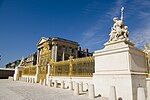Equestrian statue of Louis XIV (Versailles)
Allegorical sculptures in FranceEquestrian statues in FranceLouis XIVMonuments and memorials in FrancePalace of Versailles ... and 2 more
Sculptures in FranceVersailles

The equestrian statue of Louis XIV is a bronze equestrian statue of the King of France Louis XIV, located on the Place d'Armes in front of the Palace of Versailles. Until 2008–2009, it was located in the cour d'honneur.
Excerpt from the Wikipedia article Equestrian statue of Louis XIV (Versailles) (License: CC BY-SA 3.0, Authors, Images).Equestrian statue of Louis XIV (Versailles)
Place d'Armes, Versailles
Geographical coordinates (GPS) Address Nearby Places Show on map
Geographical coordinates (GPS)
| Latitude | Longitude |
|---|---|
| N 48.803333333333 ° | E 2.1258333333333 ° |
Address
Place d'Armes
Place d'Armes
78000 Versailles, Notre-Dame
Ile-de-France, France
Open on Google Maps











